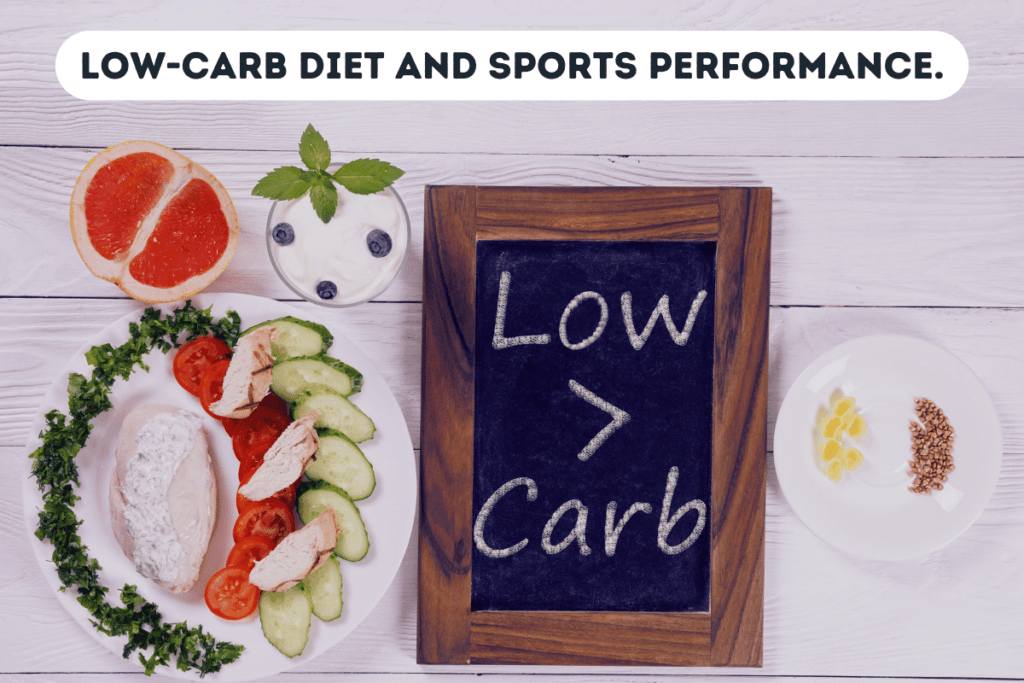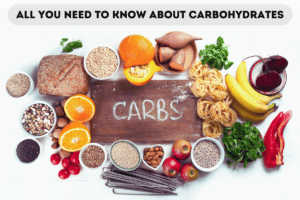In the previous article on carbohydrates, “All You Need to Know About Carbohydrates”, we discussed the structure of carbohydrates, including simple and complex carbohydrates, fibre, and it’s significance. We also covered topics such as glycemic index (GI) and carbohydrate requirements for adults. In this article, we will focus on carbohydrate requirements for athletes. Carbohydrates play a crucial role in fueling various activities, and the amount of glycogen stored in the muscles and liver directly impacts exercise performance. High muscle-glycogen levels allow for optimal training intensity and greater training effectiveness, while low levels lead to early fatigue, reduced intensity, and suboptimal performance.
This article will delve into the significance of carbohydrates in athletic performance, examining the role of glycogen, the necessary carbohydrate intake, pre-, during, and post-exercise nutrition, the advantages of a low-carbohydrate diet, and strategies for carbohydrate loading. Let’s begin by understanding why carbohydrates are vital for athletic performance by exploring the primary energy sources for our body.
Primary energy sources for the body.
Muscle glycogen and free fatty acids are the primary body fuel for athletic activity. Protein is also used as an energy source during exercise but is only a small contribution (5-10%) to the total energy production. As exercise intensity increases, the percentage of CHO used for energy increases, and the rate of fat decreases. If you exercise at low intensity (less than 50% of VO2max) – the primary fuel is fat. During moderate-intensity exercise (50–70% VO2 max), muscle glycogen supplies around half your energy needs; the rest comes from fat. When your exercise intensity exceeds 70% VO2 max, muscle glycogen provides 75% of your energy needs. So, we can state that we need carbohydrates during moderate-intensity exercises and especially during high-intensity exercises (more than 70% VO2 max). You can find more explanation about energy sources in my article: “Energy systems or how to double your training results“.
What is glycogen, and why it’s so important?
Let’s look at the process of carbohydrate digestion. During digestion, all carbohydrates we consume are broken down into simple sugars, such as glucose. Then, simple sugars pass through the walls of the small intestine into the bloodstream. From there, glucose can be used to supply instant energy or stored as glycogen in the liver and muscles. If there is too much sugar for the body’s needs, it will be converted into fatty acids in the liver and stored as body fat.
The body can store only a small amount of carbohydrates as glycogen. For a person weighing around 80 kg, the total amount of glycogen would be around 500 g (400g in muscles and 100g in the liver). The total energy stored in glucose and glycogen will be 2,000 kcal (500g * 4 = 2000 kcal). A store of 2,000 kcal is just about enough to fuel your body for one day without eating or to perform two hours of high-intensity exercise. That is why maintaining a carbohydrate-rich diet is essential for athletes, sports people, and regular exercisers whose glycogen stores can quickly deplete.

The amount of glycogen you can store also depends on such factors as how fit you are and how many muscles you have. The fitter you are, the more glycogen your body can store. For example, endurance athletes have a higher capacity to store glycogen. As to muscle mass, glycogen storage capacity increases with increased muscle mass. The more muscles you have, the more glycogen you can store.
Another benefit of storing glycogen for athletes is that it is good for hydration. Every molecule of glycogen is bound to three molecules of water. So, when athletes increase their carbohydrate intake to optimise their glycogen stores, they also manage their hydration status. This is also why low carbohydrate or starvation diets lead to rapid weight loss in the first few days. During low-carb or starvation diets, you lose glycogen stores in the liver and muscles, with its associated water molecules. The rapid weight loss is not due to fat loss at all, but lost water.
How much carbohydrates should you eat per day?
Although the Department of Health recommends an intake of 50-55%, there is much disagreement about what an ideal level of carbohydrate intake is. Some population groups may benefit from a lower or higher carbohydrate intake. For example, for an athlete who needs 5000 calories daily, 55% energy from carbohydrates would give him 687g of carbohydrates (55% from 5000kcal = 2750kcal /4 = 678,5g of carbs). These amounts of carbs will exceed their glycogen storage capacity. On the other hand, athletes consuming 2000 calories daily would not get enough carbohydrates to maintain muscle glycogen stores (55% from 2000 kcal = 1100 kcal/4 = 275g of carbs). The total store of glycogen in the average body amounts to about 500g – approximately 400g in the muscles and 100g in the liver.
That is why it’s better to calculate your carbohydrate requirement based on your training volume and body weight. Looking at our training volume is essential because the more significant our training volume is, the more carbohydrates we need to fuel our muscles. As to our body weight, our glycogen storage capacity is roughly proportional to our muscle mass and body weight. In other words, the heavier you are and the greater your muscle mass is, the greater your glycogen storage capacity. Below is a table showing how much carbohydrates you should eat daily (Table No1. Guidelines for daily carbohydrate intake).
| Activity level | Recommended carbohydrate intake |
| Very light training (low intensity or skill-based exercise) | 3–5 g/kg BW daily |
| Moderate intensity training (approx 1 h daily) | 5–7 g/kg BW daily |
| Moderate–high intensity training (1–3 h daily) | 6–10 g/kg BW daily |
| Very high intensity training (> 4 h daily) | 8–12 g/kg BW daily |
Carbohydrates before exercise
What, when and how much you eat before exercise will affect your performance, strength, and endurance. Ideally, you should consume between 2 and 4 hours before training, leaving enough time for your stomach to settle so that you feel comfortable – not too full and not too hungry. This helps increase liver and muscle glycogen levels and enhances your subsequent performance. The closer you are to the start of your training session, the smaller your meal should be, whereas larger meals can be consumed when more time is available before training or competition. The best is to eat between 1–4 g/kg of body weight and 1–4 hours before exercise. Some studies suggest 200–300 g carbohydrate or 2.5 g carbohydrate/kg of body weight about 3 hours before exercise.
You may need to experiment to find the exact quantity of food or drink and the timing that works best for you. Some athletes can consume a substantial meal 2–4 hours before exercise with no ill effects, while others may experience discomfort and prefer to eat a snack or liquid meal. The rule is to eat a low-GI meal based on the idea that such a meal would supply sustained energy during exercise. As to high GI foods, they are riskier to your performance, mainly if you are sensitive to blood sugar fluctuations. Get the timing wrong, and you may be starting exercise with mild hypoglycaemia –a rapid rise in blood sugar and a short-lived dip afterwards. The safest strategy may be to stick with low GI pre-exercise and then top up with high GI carbohydrate during exercise if you are training for more than 60 minutes. The examples of pre-workout meals 2–4 hours before exercise would be:
- Sandwich/roll/bagel/wrap filled with chicken, fish, cheese, egg or peanut butter and salad.
- Pasta with tomato-based pasta sauce and cheese and vegetables.
- Chicken with rice and salad.
- Mixed bean hot pot with potatoes.
- Chicken and vegetable casserole with potatoes.
- Porridge made with milk.
- Fish and potato pie.
Pre-workout snacks 1–2 hours before exercise:
- Fresh fruit.
- Dried apricots, dates, or raisins.
- Yoghurt.
- Shake (home-made or a meal replacement shake);
- Energy or nutrition bar.
- Cereal bar or flapjack.
Carbohydrates during exercise
For endurance activities lasting less than 45 minutes to 1 hour, consuming anything other than water is unnecessary (if you have consumed sufficient carbohydrates during the previous few days and eaten a meal containing carbohydrates 2–4 hours before exercise, and your pre-exercise muscle glycogen levels are high). If you are training low (in glycogen depleted state), there are a few good tips for improving your performance. The first option is pre-workout supplements (they give you more energy, primarily because of high caffeine intake. But you need to be careful with these supplements because using them too often can badly affect your heart (again because of high caffeine content). If you don’t like pre-workout supplements, you can try drinking just a cup of strong coffee or double expresso 20 min before training.
The second option is BCAA. BCAA can help you save muscles during training and give you a little bit more energy. It’s a good option if you are losing weight and training in a depleted state. You can use BCAA in capsules or powder. I prefer powder because it’s a cheaper version and motivates me to drink more water.
The third option is a carbohydrate rinsing technique. Researchers have found that simply rinsing the mouth with a carbohydrate drink for 5–10 seconds improves performance even when you do not swallow the drink. The ergogenic effects of mouth-rinsing are thought to be due to carbohydrate receptors in the mouth signalling to the brain that food is on its way (placebo effect). All in all, you can continue exercising without consuming any carbohydrates. As for me, this technique is a waste of a drink, so I don’t use it. It probably can be beneficial for marathon runners. In all other cases, if you are not training in a carbohydrate-depleted state, carbohydrates are the best energy source for training. Now, let’s return to the discussion about “What carbs to use during exercise.”
For moderate–high-intensity exercise lasting longer than 60–90 minutes, consuming extra carbohydrates can help maintain blood glucose levels, delay fatigue, and enable you to perform longer at a higher intensity. It may also help you continue exercising when your muscle glycogen stores are depleted. The recommendation is to take an extra 30–60 g of carbohydrates/hour. For intense exercise lasting more than 2½ hours, consuming more significant amounts of carbohydrates, up to 90 g/hour, would be beneficial.
The carbohydrates you consume during exercise should raise your blood sugar level and reach your exercising muscles rapidly. That’s why high or moderate GI carbohydrates are generally the best choices. You can choose solid or liquid carbohydrates, and there are many different choices. Most athletes (me as well) find liquid forms of carbohydrates (sports drinks) more convenient. Carbohydrate-containing drinks have a dual benefit because they provide fluid and fuel, reducing dehydration and fatigue. It is essential to begin consuming carbohydrates before fatigue sets in because it takes 30–40 minutes to absorb carbohydrates into the bloodstream. The best strategy for workouts longer than 60–90 minutes is to begin consuming carbohydrates after about 30–40 minutes.
SUMMARY OF RECOMMENDATIONS FOR CARBOHYDRATE INTAKE DURING EXERCISE.
| Exercise duration | Recommended amount of carbohydrates | Type of carbohydrate |
| <45 minutes | None | None |
| 45-75 minutes | Very small amounts (mouth rinse) | Any |
| 1-2 hours | Up to 30 g/h | Any |
| 2-3 hours | Up to 60 g/h | Glucose, maltodextrin |
| >2,5 hours | Up to 90 g/h | Multiple transportable carbohydrates (glucose + fructose, or maltodextrin + fructose in 2:1 ratio) |
SUITABLE FOODS AND DRINKS TO CONSUME DURING EXERCISE.
| Food or drink | Portion size providing 30 g carbohydrate | Portion size providing 60 g carbohydrate |
| Isotonic sport drink (6g/100ml) | 500 ml | 1000 ml |
| Glucose polymer drink (12g/100ml) | 250 ml | 500 ml |
| Energy bar | 0,5-1 bar | 1-2 bars |
| Diluted fruit juice (1:1) | 500 ml | 1000ml |
| Raisins or sultanas | 1 handful (40g) | 2 handfuls (80g) |
| Cereal or breakfast bar | 1 bar | 2 bars |
| Energy gel | 1 sachet | 2 sachets |
| Bananas | 1-2 bananas | 2-3 bananas |
Carbohydrates after exercise
Research has shown glycogen storage following exercise occurs in three distinct stages. During the first 2 hours, replenishment is most rapid – at approximately 150% (or one-and-a-half times) the regular rate. The rate slows down during the subsequent 4 hours but remains higher than normal. After this period, glycogen manufacture returns to the regular rate. Therefore, eating carbohydrates during this time speeds up glycogen recovery. This is most important for those athletes who train twice a day. However, for 24 hours or longer recovery periods, the type and timing of carbohydrate intake is less critical, provided you consume enough energy (calories) and carbohydrates over a 24-hour.
For rapid recovery, most researchers recommend consuming 1–1.2 g/kg body weight early in the post-exercise period and, ideally, within 4 hours. Even if you finish training late in the evening, you still need to start the refueling process, so do not go to bed on an empty stomach! For efficient glycogen refueling, you should continue eating carbohydrates at regular intervals. If you leave long gaps without eating, glycogen storage and recovery will be slower.
The length of time that it takes to refuel depends on four main factors:
- How depleted your glycogen stores are after exercise. The more depleted your glycogen stores, the longer it will take you to refuel, just as it takes longer to refill an empty fuel tank than one that is half full. This, in turn, depends on the intensity and duration of your workout. The higher the intensity, the more glycogen you use.
- The extent of muscle damage. Specific activities that involve eccentric exercise (e.g., heavy-weight training, plyometric training, or hard running) can cause muscle fibre damage. This, in turn, delays glycogen storage, and complete glycogen replenishment could take as long as 7–10 days.
- The amount and the timing of carbohydrates you eat. The higher your carbohydrate intake, the faster you can refuel your glycogen stores. A high carbohydrate intake is essential for glycogen recovery and subsequent performance for those training twice a day. Therefore, if you wish to train daily or twice a day, ensure you consume enough carbohydrates. If not, you cannot train as hard or as long as you want. You will suffer fatigue sooner and achieve smaller training gains.
- Your training experience and fitness level. Efficiency in refueling improves automatically with training experience and raised fitness levels. Thus, it takes a beginner longer to replace his glycogen stores than an experienced athlete eating the same amount of carbohydrates. That’s why elite sportspeople can train almost daily while beginners cannot and should not!
When the recovery period between training sessions is less than 8 hours, you should eat as soon as possible after the first workout to maximise recovery. During the early recovery phase, several smaller, high-carbohydrate snacks may be more effective than larger meals. Whether you consume liquid or solid forms of carbohydrates does not affect the glycogen storage rate. Here is an example of post-exercise snacks. Each of the following provides 60–90 g carbohydrate and 15–25 g protein:
- 500 ml flavoured milk, one cereal bar, one banana.
- Two bananas, 500 ml of semi-skimmed milk.
- A wholemeal tuna sandwich (two slices of bread, 50 g tuna) and one pot (150 g) of yoghurt.
- Recovery milkshake: Mix 300 ml low–fat milk, one pot (150 g) fruit yoghurt, one banana, 100 g strawberries, and two heaped tsp (30 g) honey in a blender.
- A wholemeal cheese sandwich (two slices bread, 40 g cheese), 100 g dried apricots.
- 200 g baked beans on two slices of wholemeal toast.
- Two cereal bars plus 500 ml skimmed milk.
- 60 g raisins and 50 g nuts.
- A jacket potato (200 g) with 200 g baked beans and 40 g cheese.
- Cooked pasta (85 g uncooked weight) with 130 g chicken breast.
- Three oatcakes, 60 g hummus, 500 ml low-fat milk.
What is the best for recovery – high GI or low GI carbohydrates?
Since high-GI foods cause a rapid increase in blood glucose levels, it seems logical that they would increase glycogen replenishment during the initial post-exercise period. Research also shows that moderate and high-GI carbohydrates, compared with low-GI carbohydrates, get faster glycogen replenishment during the first 6 hours after exercise (especially the first 2 hours).
However, researchers also state that, after 24 hours, muscle glycogen storage is about the same on a low GI diet. In other words, moderate and high GI foods will give you faster glycogen replenishment during the first 6 hours after exercise, but low GI foods will result in the same level of recovery 24 hours after exercise. The bottom line is that if you are training intensely every day or twice a day, make sure you consume high-GI foods during the first 2 hours after exercise. However, if you train once daily (or less frequently), low-GI meals will be enough for recovery.
And one more tip. For better recovery you should eat not just carbohydrates but protein as well. Combining a small amount of protein (0.2–0.4 g/kg BW/h) with less carbohydrate (0.8 g/kg BW/h) is equally or more effective in promoting glycogen recovery than carbohydrate alone. Researchers found that a carbohydrate-protein drink (112 g carbohydrate, 40 g protein) increased glycogen storage by 38% compared with a carbohydrate-only drink.
What are the benefits of low carbohydrate diets?
If you read my article: “Energy systems“, you probably know that carbohydrates are the primary energy source for exercise. Especially if you are doing high-intensity training and your glycogen stores are low, your performance will decrease, and your body will burn your muscles to get energy for training. But not looking at this fact, there is a benefit to exercising with low glycogen stores (let’s also call it ‘training low’).

Low carbohydrate diets suit those who do mainly low to moderate-intensity training and those wanting to lose weight. Exercise at low intensity (less than 50% of VO2max) is fueled mainly by fat. So, if you start training low (having low glycogen stores in your muscles) and your exercise intensity is low, your body will use more fat as energy source. But if your training intensity exceeds 50% of VO2 max, you will start burning muscles. Now, let’s look at the number of ways how you can train low.
First, sitting on a low carbohydrate diet all the time and ‘training low’ is not a good idea. This method may improve fat adaptation but will result in a reduced capacity for high intensity exercise. It may also reduce immune function and increase the risk of illness. The most famous ‘train low’ protocol and the easiest to adopt is when you are training low in the morning before breakfast, following an overnight fast, without consuming carbohydrates during the workout.
The best way to use this strategy is to perform a high intensity training session in the evening to deplete muscle glycogen, this is followed by an overnight fast, so muscle glycogen stores are not replenished (you don’t eat after training). The next morning (when glycogen stores are low) a light training session is carried out on an empty stomach. After this, glycogen stores are replenished by consuming normal meals for the rest of the day.
Another strategy you can use is carbohydrate periodisation. The low-intensity sessions are performed with low glycogen stores and high-intensity sessions with high glycogen stores. For example, on day one, you perform high-intensity resistance training (with high glycogen stores). The next day, you make a low-intensity cardio session (with low glycogen stores). The idea is to match your carbohydrate intake to your training sessions, which will improve your metabolic flexibility, and your muscles will be able to switch between burning fat and carbohydrates when necessary.
Of course, how you organise your training sessions will depend on many factors, including training goals, frequency and intensity of training, lifestyle, and individual make-up.
Carbohydrates loading strategy
Carbohydrate loading is a technique which was developed to increase the muscle’s glycogen stores above normal levels. With more glycogen available, you can exercise longer before fatigue sets in. This is advantageous in endurance events lasting longer than 90 minutes (for example, long-distance running or cycling) or for events that involve several heats or matches over a short period (for example, tennis tournaments or swimming galas). It is unlikely to benefit you if your event lasts less than 90 minutes because muscle glycogen depletion would not be a limiting factor to your performance. Carbohydrate loading increases time to exhaustion by about 20% and improves performance by about 2–3%. Now, let’s look at what carbohydrate-loading strategies you can use.

All carbohydrate-loading strategies involve increasing the number of carbs you eat and temporarily decreasing the intensity of you exercise. Each of these programs is designed to be completed in the days immediately prior to an athletic event or competition. Here are some examples of such strategies:
- Classic 6-Day. During the first three days of this program, you exercise as normal while consuming a low-carb diet that gives you about 15% of calories from carbs. The combination of exercise and low carbohydrate intake decreases your body’s glycogen stores. During days four to six of this program, you consume a high-carb diet that gets about 70% of its calories from carbs. You also reduce intensity of exercises on day four and don’t exercise on days five and six.
- 6-Day. For the first three days, this program involves eating a moderate-carb diet that gives you about 50% of its calories from carbs and exercising as normal. This is followed by three days of a high-carb diet, with about 70% of calories from carbs. Throughout these six days, you gradually decrease the amount of your exercise. During days four to six, you do only 0–20 minutes of exercise per day.
- Classic 3-Day.This program is shorter and simpler than the six-day programs. At the beginning of the three days, you are doing one exercise session until your body is exhausted. For the remaining of the three days, you are not exercising, but consuming a high-carb diet that gets about 70% of its calories from carbs.
- Modified 3-Day. This program is identical to the classic three-day program, but you are not doing the exercise session at the beginning. Instead, you simply do not exercise for three days, while increasing the number of carbs you eat. Research on this program used a carbohydrate intake of 10 grams per kg of body weight per day. This would be about 700 grams of carbs if you weighed 70 kg.
- 1-Day. The one-day program is the simplest of them all. You do not exercise for one day, and you consume a high-carb diet of about 10 grams per kg of body weight.




